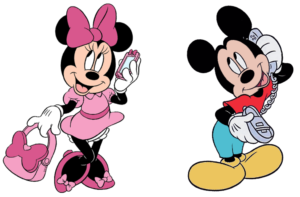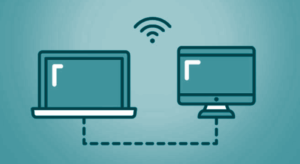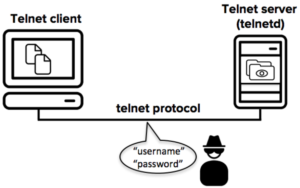
One day Mickey was in the garden when he saw Minnie
Mickey – Hi Minnie, How are you
Minnie – I am good
Mickey – What happened, you look lost
Minnie – Nothing was just thinking about something
Mickey – Common, you can tell me
Minnie – I need to study Telnet so I can explain it to my class tomorrow
Mickey – Oh, that’s it! Let me help you
Minnie – Wow
Mickey – Suppose you need to talk to your friend who is away from you. What do you do?
Minnie – Well, I can use a telephone

Mickey – Exactly, like telephone helps you to connect with your remote friend, telnet allows remote computers to connect with each other

Minnie – Tell me more, is it a device
Mickey – Telnet is a protocol (a program or a language)
Minnie – So what does it actually stand for
Mickey – Telnet = Teletype over Network (protocol)
It was named like this because it is a protocol that provides a command-line interface for communication with a remote system
Telnet was developed in 1969
Minnie – Okay so it’s like sending and receiving data between remote computers
Mickey – Exactly, but you see in Telnet the information is exchanged in plain text, so there is no in-built security or encryption. A more secure option in SSH
Hope you remember The Story of SSH
Minnie – Yes, I do, So is it now replaced by SSH
Mickey – Not replaced, but yes today SSH is mostly used than Telnet
People still use Telnet for things like
to see if a service is listening on a remote system by typing
“telnet servername <port number>“
and several other things
Minnie – This is done from the command line
Mickey – Yes, If you want to check if a web server is alive and you are running command line only, you can run this command
telnet servername 80

Image credits – https://www.ssh.com/ssh/telnet
Minnie – I am getting this
Mickey – So Telnet is Network Protocol used on the Internet or local area networks to provide a bidirectional interactive text-oriented communication
Okay let’s make it even more simple for you, Let’s break it down term by term
- Network protocol – It’s basically a language or program to enable machines to talk to each other
- Bidirectional – this means Telnet works both ways, can be used to send and recieve information
- Interactive – means Telnet expects a Live user on one end of the line. Its not for computers to talk autonomously with each other, but was built from the ground up to be human-readable
- Text-oriented – It’s a text-only protocol, you won’t see any images or graphics, nor can you transfer files with Telnet
Minnie – Wow, Now I get this
Mickey – A telnet session will look like this

Minnie – I am feeling so good Mickey
Mickey – Do you want to go home
Minnie – No, let’s just sit here and watch the sunset
Mickey – Okay
Minnie – You are my best friend
Mickey – I am always here for you 🙂
about the author | more stories
References
https://en.wikipedia.org/wiki/Telnet
https://www.makeuseof.com/tag/telnet-makeuseof-explains/